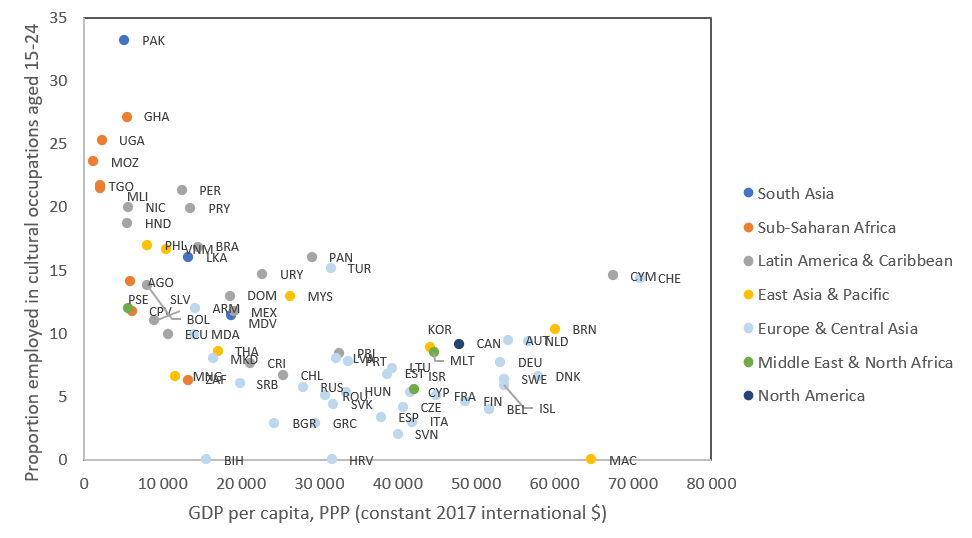 Creative and cultural jobs represent a promising avenue for inclusive and resilient growth. Copyright: Ariyo Olasunkanmi/Shutterstock
Creative and cultural jobs represent a promising avenue for inclusive and resilient growth. Copyright: Ariyo Olasunkanmi/Shutterstock
Cultural and creative industries, or the orange economy, account for an estimated 50 million jobs worldwide and employ more young people (15–29-year-olds) than other sectors. In the face of acute and growing labor market challenges, especially among youth and vulnerable groups, creative and cultural jobs represent a promising avenue for forging more inclusive and resilient growth.
As explored in the Solutions for Youth Employment (S4YE) report, Orange Economy: As a Driver of Jobs for Youth, cultural and creative industries, such as art, crafts, films, video games, fashion, and music, preserve traditions and expand our worldviews. As a step toward realizing the sector’s promise to bolster diversity and youth employment, S4YE has partnered with the project Cultural and Creative Industries—which is implemented by GIZ (Deutsche Gesellschaft für Internationale Zusammenarbeit GmbH) and the Goethe-Institut on behalf of the German Federal Ministry for Economic Cooperation and Development (BMZ)—and established the Creative Economy Alliance. The Creative Economy Alliance for Diversity and Youth is a global multi-stakeholder partnership that brings key organizations together to share a commitment to enhance productive and diverse youth employment in the creative industries.
Shocks affecting job prospects, particularly for youth
The continued aftershocks of the COVID-19 pandemic accelerated the adoption of digital platforms used for payment, logistics, and digital marketplaces, leaving behind many creators who live in areas with limited internet access—underscoring the need to increase the resilience of labor markets across the globe.
Youth bear the burden of growing unprecedented shocks and face higher risks of job instability and insecurity, with the potential for repercussions throughout their careers . About a quarter of all young people in developing countries were neither in education, employment, or training in 2021. The negative effects of lower employment levels and reduced wages caused in part by the pandemic have the potential to resonate throughout their lifetimes and can have broader economic impacts.
How the creative and cultural industries respond to youth job challenges
1. Creative and cultural industries have the potential to offer more shock-resilient employment opportunities. Creative and cultural industries have weathered previous financial crises better than other sectors. Following the 2008 financial crisis, these industries continued to grow despite a 12 percent contraction in world trade, with creative goods and services amounting to $592 billion and growing 14 percent annually from 2002 to 2008. Similarly, creative services performed better than other service sectors following the COVID-19 pandemic, seeing only a 1.8 percent decline in exports in 2020 relative to a 20 percent contraction in the export of all services. The creative sector is moreover playing an increasingly prominent role in the global economy, with creative goods and services accounting for 3 and 21 percent respectively of overall merchandise and services exports in 2020.
2. Creative and cultural industries are more inclusive, promoting both gender and youth-driven growth, particularly in the developing world. The proportion of women employed in cultural occupations is higher than in non-cultural occupations in nearly 60 percent of countries. Across low-income and lower-middle-income countries, individuals aged 15 to 24 accounted for nearly one-fourth of all employment in cultural occupations, with youth representation high in Sub-Saharan Africa and Latin America and the Caribbean in particular (Figure 1). Youth accounted for nearly one-third of employment in creative occupations in Pakistan, over one-fourth of creative jobs in Ghana and Uganda, and one-fifth and upwards of creative occupations in Mozambique, Mali, Togo, Peru, and Nicaragua.
Figure 1. Proportion of individuals employed in cultural occupations aged 15-24 by GDP per capita, PPP, latest available data

3. The cultural and creative sector generates employment for individuals with less than secondary school attainment, a demographic often most vulnerable to job instability (Figure 2). Across low-income and lower-income countries, those that have not completed secondary schooling accounted for 27.3 percent of those employed in cultural occupations and 15 percent of those employed in creative industries.
Figure 2. Proportion of individuals employed in cultural occupations or cultural industries with primary education or less by income group, latest available data

4. The creative economy offers a more sustainable pathway toward growth, aligned with environmentally sustainable and eco-friendly practices. Local craftworks, handicrafts, and artisanal products frequently employ small-scale, environmentally sound production processes. Creative entrepreneurs often use recycled and upcycled resources, finding productive use for materials that would otherwise end up in landfills. Sectors such as the fashion industry have begun the transition to greener and more circular practices including growth in the secondhand clothing market and more sustainable raw inputs to cater to a more environmentally conscious clientele. In addition, creative workers can foster environmental awareness through musical performances, films, and exhibitions.
5. Creative industries and occupations span many sectors, employing a diversity of skillsets and talent. The potential of creative industries lies in the breadth of capabilities and potential collaborations that can be productively employed including film, fashion, video games, music, and artistry. As highlighted in “Unlocking Opportunities for Youth in the Orange Economy – Music in Africa,” the music industry serves as a strong source of youth employment in the region from across the music business, such as recording, musical composition, video editing, marketing, and promotion. More broadly, individuals from diverse socioeconomic and educational backgrounds can work in the creative economy, further underlining the sector’s promise.
Recognizing the untapped employment opportunities for vulnerable and largely underemployed groups, even during times of broader macroeconomic turmoil is crucial for prosperity and economic growth. Only an inclusive, transparent, effective, and collective network can address the global development challenges young people are facing in today’s world. Strong partnerships and knowledge sharing among global multi-stakeholders – governments/public sector, private sector, NGOs, foundations, donors, youth - will play a key role to further catalyze, amplify the impact and accelerate progress towards deploying impactful and scalable solutions in shaping the jobs of tomorrow in the creative industries.
For more information on the creative economy, please visit S4YE’s recently launched online Knowledge Repository featuring knowledge briefs, reports and additional key information on the creative economy. The repository has 95+ resources available, features 25+ organizations and includes various industries from arts, music, movies, fashion, gaming, and more. In addition, the Creative Economy Alliance’s Knowledge Notes will spotlight how the film industry, fashion industry, and disruptive technologies can contribute to ensuring that the creative sector reaches its full potential for sustained and inclusive employment and economic growth.
To receive weekly articles, sign-up here




Join the Conversation